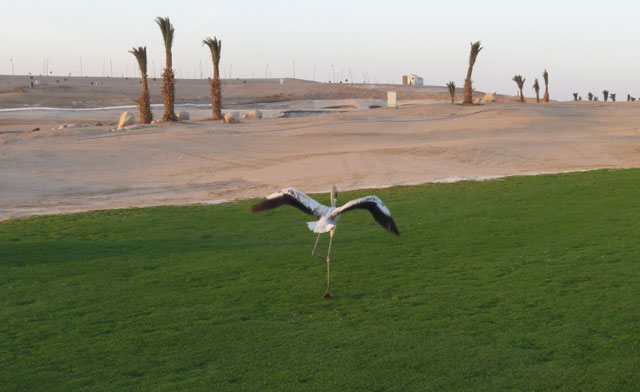AMMAN — The Royal Society for the Conservation of Nature (RSCN) has treated a greater flamingo found in a poor condition near the Dana Biosphere Reserve and released the bird, a conservationist said on Thursday.
An area resident spotted the flamingo last month and handed it over to Dana Reserve staff, Aqaba Bird Observatory Director Feras Rahahleh told The Jordan Times.
The reserve contacted the Aqaba Bird Observatory, which took the flamingo and provided it with medical care, he said, adding that the bird was brought to Aqaba because the area is similar to its natural habitat.
“The bird was exhausted. It was no longer able to carry on travelling because of the long migration route,” Rahahleh explained, noting that after the flamingo was rehabilitated and rested it was released onto the Ayla Oasis project’s golf course, which offers green landscapes and ponds.
“One day after the bird was released, it left Aqaba and continued its migration,” he said.
Flamingos pass through Jordan every year during the autumn migration and can be spotted in Aqaba and Azraq, according to the conservationist.
Greater flamingos can be found in warm, watery regions on many continents, according to the National Geographic website, which indicated that they favour environments like estuaries and saline or alkaline lakes. They thrive on the extensive mud flats where they breed and feed.
Greater flamingos are the most widespread species of the flamingo family, according to web sources.
Rahahleh noted that Aqaba is located on the Rift Valley-Red Sea route, which is the world’s second most-used flyway.
A total of 37 types of migratory soaring birds maintain flight by using rising air currents, travelling on the flyway annually. At least five of these species are globally endangered, such as white and black storks, buzzards, eagles and vultures, according to the RSCN.
Migratory birds in the southern hemisphere use the Rift Valley/Red Sea Flyway to return to Europe and the northern hemisphere in the spring. On their journey, more than 1.5 million birds stopover in places like the Jordan Valley to rest and drink water.
Rahahleh said the Aqaba Bird Observatory recorded a total of 198 bird species over the past five years, as its artificial habitats attract migratory birds.
Established in 2004, the 0.5 square kilometre observatory serves as a station for birdwatchers from around the world, according to its director, who said the Aqaba Special Economic Zone Authority gave the RSCN the authority to manage it.
